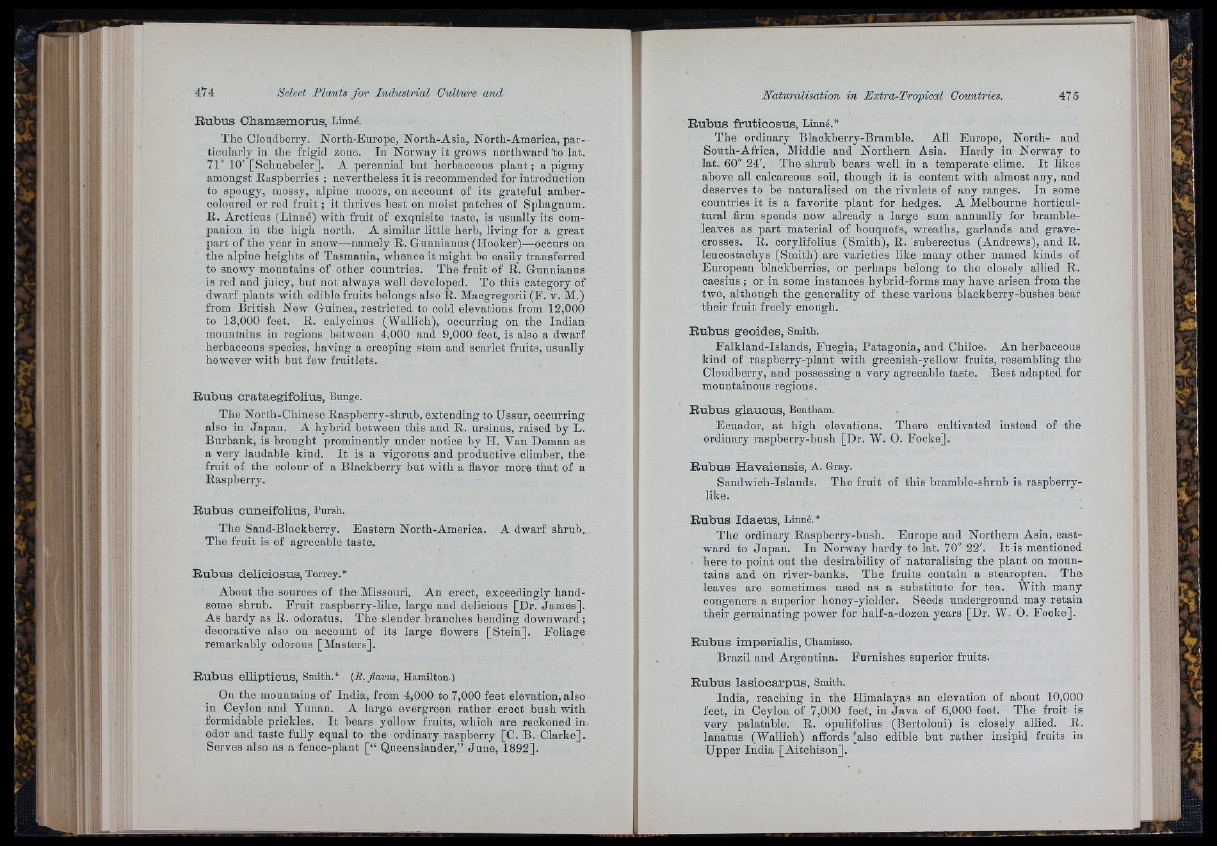
Eubus Ohamæmorus, Linné.
The Cloudberry. North-Europe, North-Asia, North-America, particularly
in the frigid zone. In Norway it grows northward 'to lat.
71° 10' [Schuebeler]. A perennial but herbaceous p la n t; a pigmy
amongst Raspberries ; nevertheless it is recommended for introduction
to spongy, mossy, alpine moors, on account of its grateful amber-
coloured or red fruit ; it thrives best on moist patches of Sphagnum.
R. Arcticus (Linné) with fruit of exquisite taste, is usually its companion
in the high north. A similar little lierb, living for a great
part of the year in snow—namely R. Gunniauus (Hooker)—occurs on
the alpine heiglits of Tasmania, whence it might be easily transferred
to snowy mountains of other countries. The frnit of R. Gunnianus
is red and juicy, bnt not always well developed. To this category of
dwarf plants with edible fruits belongs also R. Macgregorii (F. v. M.)
from British New Guinea, restricted to cold elevations from 12,000
to 13,000 feet. R. calyciuus (Wallich), occurring on the Indian
mountains in regions between 4,000 and 9,000 feet, is also a dwarf
herbaceous species, having a creeping stem and scarlet fruits, usually
however witb but few fruitlets.
Eubus crataegifolius, Bunge.
The North-Chinese Easpberry-shmb, extending to Hssur, occurring
also in Japan. A hybrid between this and R. ursinns, raised by L.
Burbank, is brought prominently under notice by H. Van Deman as
a very laudable kind. I t is a vigorous and productive climber, the
fruit of the colour of a Blackberry but with a flavor more th a t of a
Raspberry.
Eubus cuneifolius, Pursh.
The Saud-Blackberry. Eastern North-America. A dwarf shrub.
The fruit is of agreeable taste.
Rubus deliciosus, Torrey.*
Abont the sources of the Missouri. An erect, exceedingly handsome
shrub. F ru it raspberry-like, large and delicious [Dr. James].
As hardy as R. odoratus. The slender branches bending downward ;
decorative also on account of its large flowers [S te in ]. Foliage
remarkably odorous [Masters].
Rubus elliptious, Smith.* (S. flavus, Hamilton.)
On the mountains of India, from 4,000 to 7,000 feet elevation, also
in Ceylon and Yunan. A large evergreen rather erect hush with
formidable prickles. I t bears yellow fruits, which are reckoned in
odor and taste fully equal to the ordinary raspberry [C. B. Clarke].
Serves also as a fenoe-plant [ “ Queenslander,” June, 1892].
Rubus fruticosus, Linné.*
The ordinary Blackberry-Bramble. All Europe, North- and
Sonth-Africa, Middle and Northern Asia. Hardy in Norway to
lat. 60° 24'. The shrub bears well in a temperate clime. I t likes
above all calcareous soil, though it is content with almost any, and
deserves to he naturalised on the rivulets of any ranges. In some
countries it is a favorite plant for hedges. A Melbourne horticultural
firm spends now already a large sum annually for bramble-
leaves as part material of bouquets, wreaths, garlands and grave-
crosses. R. corylifolius (Smith), R. snherectus (Andrews), and R.
leucostachys (Smith) are varieties like many other named kinds of
European blackberries, or perhaps belong to the closely allied R.
caesius ; or in some instances hybrid-forms may have arisen from the
two, although the generality of these various blackberry-hnshes bear
their fruit freely enough.
Rubus geoides, Smith.
Falkland-Islands, Fuegia, Patagonia, and Chiloe. An herbaceous
kind of raspberry-plant with greenish-yellow fruits, resembling the
Cloudberry, and possessing a very agreeable taste. Best adapted for
mountainous regions.
Rubus glaucus, Bentham.
Ecuador, a t high elevations. There cultivated instead of the
ordinary raspberry-bush [Dr. W". O. Focke].
Eubus Havaiensis, A. Gray.
Sandwich-Islands. The fruit of this hramble-shrub is raspberrylike.
Rubus Idaeus, Linné.*
The ordinary Raspberry-bush. Europe and Northern Asia, eastward
to Jap an . In Norway hardy to lat. 70° 22'. I t is mentioned
- here to point out the desirability of naturalising the plant on mountains
and on river-banks. The frnits contain a stearopten. The
leaves are sometimes used as a substitute for tea. With many
congeners a superior honey-yielder. Seeds underground may retain
their germinating power for half-a-dozen years [Dr. W. 0 . Focke].
Rubus imperialis, Chamisso.
Brazil and Argentina. Furnishes superior fruits.
Rubus lasiooarpus, Smith.
India, reaching in the Himalayas an elevation of about 10,000
feet, in Ceylon of 7,000 feet, in J a v a of 6,000 feet. The fruit is
very palatable. R. opulifolius (Bertoloni) is closely allied. B.
lanatus (Wallich) affords [also edible hut rather insipid fruits in
Upper India [Aitchison].